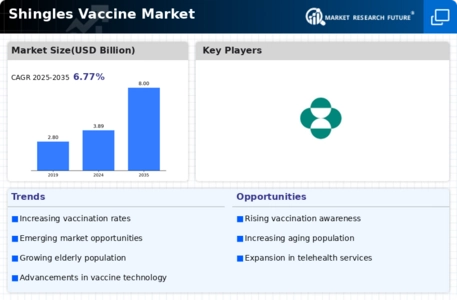Rising Healthcare Expenditure
Rising healthcare expenditure is another significant driver of the Shingles Vaccine Market. As countries invest more in healthcare infrastructure and preventive measures, the allocation of funds towards vaccination programs has increased. This trend is particularly evident in developed nations, where healthcare budgets are expanding to accommodate preventive healthcare initiatives. The emphasis on reducing the burden of diseases like shingles through vaccination is likely to result in higher vaccination rates. Additionally, as more individuals recognize the long-term cost savings associated with preventing shingles and its complications, demand for vaccines is expected to rise. This growing investment in healthcare and preventive measures is poised to bolster the Shingles Vaccine Market, as stakeholders seek to improve public health outcomes.
Increasing Incidence of Shingles
The rising incidence of shingles, particularly among older adults, appears to be a primary driver for the Shingles Vaccine Market. As the population ages, the risk of developing shingles increases significantly. Data indicates that nearly one in three individuals will develop shingles in their lifetime, with the risk escalating after the age of 50. This demographic shift is likely to propel demand for vaccination, as healthcare providers emphasize preventive measures. Furthermore, the World Health Organization has recognized shingles as a public health concern, which may lead to increased funding and resources allocated towards vaccination programs. Consequently, the growing awareness of shingles and its potential complications, such as postherpetic neuralgia, is expected to enhance the uptake of vaccines, thereby stimulating the Shingles Vaccine Market.
Advancements in Vaccine Technology
Advancements in vaccine technology are significantly influencing the Shingles Vaccine Market. The development of more effective and safer vaccines, such as the recombinant zoster vaccine, has shown promising results in clinical trials, demonstrating higher efficacy rates compared to previous formulations. These innovations are likely to enhance public confidence in vaccination, leading to increased uptake. Moreover, ongoing research into new delivery methods and formulations may further expand the market. The introduction of combination vaccines that address multiple diseases, including shingles, could also attract a broader audience. As healthcare providers and patients become more aware of these advancements, the Shingles Vaccine Market is expected to experience substantial growth, driven by the demand for cutting-edge vaccine solutions.
Increased Focus on Preventive Healthcare
The increased focus on preventive healthcare is reshaping the Shingles Vaccine Market. With a growing understanding of the importance of vaccination in preventing diseases, healthcare providers and patients alike are prioritizing preventive measures. This shift in mindset is particularly pronounced among older adults, who are more susceptible to shingles and its complications. Educational campaigns highlighting the benefits of vaccination are contributing to this trend, as they inform the public about the risks associated with shingles. Furthermore, the integration of vaccination into routine healthcare practices is becoming more common, making it easier for individuals to receive the shingles vaccine. As preventive healthcare continues to gain traction, the Shingles Vaccine Market is likely to benefit from increased demand and a more proactive approach to health management.
Government Initiatives and Recommendations
Government initiatives and recommendations play a crucial role in shaping the Shingles Vaccine Market. Various health authorities, including the Centers for Disease Control and Prevention, advocate for vaccination among older adults, particularly those aged 50 and above. These recommendations are often accompanied by public health campaigns aimed at educating the population about the benefits of vaccination. In some regions, government subsidies or reimbursement policies for shingles vaccines have been implemented, making them more accessible to the public. Such initiatives not only encourage vaccination but also contribute to the overall growth of the market. The proactive stance taken by governments worldwide in promoting vaccination against shingles is likely to result in increased immunization rates, thereby driving the Shingles Vaccine Market forward.


















Leave a Comment